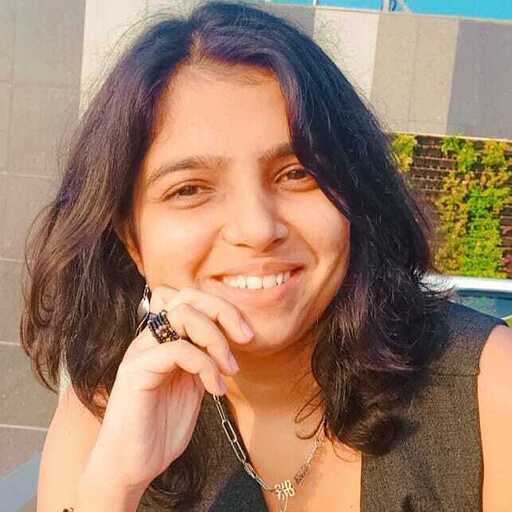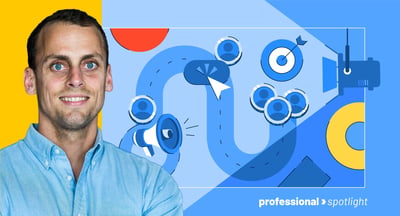March 6, 2024
 by Samudyata Bhat / March 6, 2024
by Samudyata Bhat / March 6, 2024

Building a startup is no walk in the park.
It's a constant race fueled by passion, caffeine, and a sprinkle (okay, maybe more than a sprinkle) of recklessness. If you're thinking about joining the race, there’s no better way to succeed than to learn from experts who have been around the block a few times.
I had such a great time chatting with Praveen Das, co-founder of Factors.ai. We discussed approaching B2B marketing strategies, building account intelligence, and his journey from the corporate world to his current role, where he wears many hats.
This interview is part of G2’s Professional Spotlight series. For more content like this, subscribe to G2 Tea, a newsletter with SaaS-y news and entertainment.
What's your favorite beverage, and when do you enjoy it? My favorite beverage is tea, which I usually enjoy in the mornings, around 7 am.
What was your first job? My first job was at a bank called HSBC in Bombay, India. I joined them in June 2010.
What's your favorite software in your current tech stack? My favorite software currently has to be Slack. That’s how most of my work gets done – it meets productivity, and at the same time, it's fun to use, and that’s a rare combination!
Samudyata Bhat: Let's begin by revisiting your professional journey. Can you share an overview of your professional journey and how you arrived at your current role as co-founder at Factors.ai?
Praveen Das: I started my career in 2010 at HSBC Bank in Bombay with a corporate banking role immediately after my MBA. I was there for around two and a half years, but did not enjoy the role and the city. That is when I decided to return to my hometown, Kochin, in Kerala, India. Here, I started a small business that revolved around investment, consulting, and raising funds for startups. It was a boutique investment advisory firm, which worked out for about nine months before I had to shut down the operation.
I then moved to Bangalore and joined InMobi, which is into mobile advertising. While my background is largely in finance and investment banking, by pure chance, I ended up working with the head of products there. After a few months, there was an opening for a product management role, which I gave my shot at. I took up that role for about six years, after which I decided to do something more exciting and step out of my comfort zone.
That is when I met my two co-founders, one who was a colleague at InMobi and the other who was his friend – and we decided to start Factors.ai.
At Factors.ai, I continue to take care of product, marketing, design, and customer success.
Wow, it’s definitely been a journey. What do you think were some key challenges that shaped your career?
I definitely made some uninformed decisions and choices. For example, first, I pursued electronics and communications as my major in engineering, which, in retrospect, was a terrible choice. Unless you are really passionate about that space.
Second, even after my MBA, I went by many stereotypes. For instance, “If you are good at mathematics, finance is the way to go.” Some of these things are so deeply ingrained that, over time, you tend to believe that it's true. I started my career in finance, genuinely disliked it, and did not see myself continuing that in the long term.
So, I made a few mistakes like these that were challenging to maneuver around. Fortunately for me, I was lucky enough to get opportunities to path-correct. And even with a few setbacks and career hits, with respect to time or energy, it did not matter because it all ended up working well for me.
The takeaway here is not to go by what people think, or follow standard and conventional paths, and lean toward what you truly think is best for you.
It's definitely essential to self-educate before making important decisions. So, deep-diving into your role as a leader, can you talk to us about your leadership style and how it has evolved over the years?
When I started my managerial career at HSBC, more often than not, I knew the right way to go, considering I had a lot to learn from past mistakes. This has pros and cons, a significant con being micromanagement. Especially when it comes to working together with people on something that I have experience with, and mostly with the intent of trying to be efficient and avoiding mistakes. So, in the first couple of years, I was micromanaging a lot of work with people, which might have stifled their creativity and decision-making.
When I founded Factors.ai, I realized that the same style would not work due to time and knowledge constraints. To give you some background, at Factors.ai, I manage a team of around 16 people out of 45 in the company. It spreads across product management, marketing, design, and customer success, which are relatively vast areas. And I do not have much personal experience in every single one of these areas. For example, within marketing itself, there’s content, social media, etc. Moreover, there are constraints on time and knowledge. Not only is there less time to look at each and everything actively, but also a lack of domain expertise. And I believe it is vital to recognize that.
To that extent, now I focus a lot more on setting the right direction and having enough checks and balances to say, “Are we continuously trying to improve?” or “Are we continuously trying to get better?” and “What more can we do to improve something?”
This has been my most significant leadership change. I've transitioned from a micromanagement mindset to one focused on empowering my team through clear direction, robust review processes, and well-organized systems.
“It is not delegation without accountability.”
Praveen Das
Co-founder, Factors.ai
With AI evolving by the day, how do you see your organization changing in the next five years? What strategies do you use to stay ahead of the curve?
I think of this in multiple ways.
The potential for AI to boost internal productivity within companies is immense. My own experience highlights this, particularly in areas where valuable knowledge gets siloed or buried in documents. Let me give you a real-life example.
We are looking to hire a content marketer, and she is expected to join us soon. Now, the gap here is how to give her every piece of information accumulated over the last few years at the company in an easy-to-understand way. Today, the only way to do this is to have someone sit with her and explain how everything has been or is expected to be. In reality, this often involves time-consuming, inefficient training sessions.
Here's where AI steps in.
Imagine an AI-powered knowledge base that comprehensively captures and organizes company information. New hires could access this data at their own pace, gaining valuable insights about the company and its past and future plans. Similarly, AI-powered coaching tools could revolutionize sales training. Imagine new reps honing their skills through personalized, interactive simulations, receiving real-time feedback, and practicing client interactions in a safe, virtual environment.
By embracing AI, we can move beyond simply replicating existing tasks. Instead, we can unlock entirely new avenues for internal productivity improvement. This isn't about replacing human interaction but empowering our teams with the tools and insights they need to excel. While we continue to optimize our current processes, I think it's super important to remain open to experimentation. AI's seemingly "far-flung" possibilities might become reality sooner than we think, and I, for one, am excited to witness the transformation it brings.
Next is within our core product. As a core analytics platform, we see vast potential for AI to revolutionize user experience and decision-making. Two key areas stand out here.
One is conversational interfaces. Imagine eliminating the traditional drop-down menus and clickfests for a natural, chatbot-like interface. This "ChatGPT for Analytics" wouldn't just guide users; it would intuitively understand their needs and make data exploration frictionless, fostering faster adoption. It wouldn't feel like navigating a complex CRM tool, but rather the ease of a familiar messaging app.
The second area is exploring AI-powered actionable insights. We operate in the B2B account analytics space. Our users grapple with crucial questions like "What's the optimal next step to close this deal?" AI can provide personalized recommendations, suggesting the most impactful actions: hosting a webinar, sending targeted content, or even pinpointing the perfect white paper from a library of hundreds. This prescriptive guidance empowers sales teams to make informed decisions and accelerate deal closures.
These are just a glimpse of the exciting possibilities within our own product and across the company's broader productivity initiatives. I'm thrilled to witness how AI will reshape the way we work and unlock previously unimagined levels of efficiency and success.
Being a content marketer myself, I absolutely love these ideas with AI. You mentioned account intelligence while discussing your company. Factors.ai is broadly trusted for accurate account intelligence. What is the number one mistake you see individuals or businesses make while building account intelligence?
The biggest pitfall companies fall into is trying to address every single account signal with a targeted solution. It's overwhelming. Funding news, hiring sprees, office expansions, open roles, the vast list of readily available [buying] signals. In addition to this, there is so much public information out there that can further deluge you.
“Incremental progress is key, not solving everything at once.”
Praveen Das
Co-founder, Factors.ai
Instead of aiming for the lowest common denominator, focus on three or four [buying] signal sources that truly illuminate your accounts and leads. Consider website visitors, companies engaging with your content marketing strategies, LinkedIn ad interactions, or G2 platform checks. Master these top five signals efficiently, rather than spreading yourself thin across the entire spectrum.
Speaking of marketing and accounts, there used to be a clear distinction between different parts of the funnel – ToFu, MoFu, BoFu. Today, the line is slightly blurry because of many available touchpoints, like B2B buyers seeking recommendations from peers/communities or researching before engaging with sales. What tips do you have for go-to-market teams struggling to attribute ROI to different marketing channels, especially during today's economic downturn?
I am going to address both of these questions separately.
While I understand the appeal of categorizing activities with the "top, middle, and bottom of the funnel" framework, I find it primarily vendor-focused rather than reflecting the customer journey. It essentially maps your internal stages of nurturing leads, which may not always align with individual customer experiences.
Instead of this generic model, I propose segmenting your business based on two distinct objectives: new business acquisition and existing customer expansion (renewals and cross-selling).
Within new businesses, further granularity is valuable. Distinguish between first-time buyers going through your sales and marketing funnel for the first time and those who have interacted before but haven't yet converted. This latter group represents a significant segment within new businesses that deserves tailored strategies.
Take our company, for instance. Nearly 20-30% of our revenue comes from companies we've interacted with before. They weren't ready then, but now they're back. This highlights the need to segment your business beyond the "new business" category. Consider distinct groups: companies you're encountering for the first time, those you've engaged with previously (even if unsuccessfully), and existing clients seeking expansions or renewals.
The "ToFu, MoFu, BoFu" approach needs tailoring for each segment. For first-time interactions, focus on raising awareness: why this problem matters, available solutions, and the ROI your platform offers. Frame the problem and value proposition to guide them through your process seamlessly.
However, companies familiar with your sales cycle don't require the same heavy lifting. Briefly acknowledge their experience, then zero in on what's changed in their business that reignites their interest. Skip unnecessary stages and move quickly to their new needs. Finally, expansion plans necessitate a different lens. Analyze their current usage patterns and identify opportunities to upsell or cross-sell.
You gain deeper marketing insights by segmenting your approach beyond the standard "ToFu, MoFu, BoFu" into these distinct categories (new logos, existing logos, expansion, or renewal). Regarding channels, attributing pipeline or revenue solely to one channel is often inaccurate, especially for higher-priced products ($10,000+ per year). Complex B2B sales rarely hinge on a single touchpoint like a Google ad. Models like "first touch" or "last touch" oversimplify the journey, making a more nuanced approach crucial.
Instead of solely attributing pipeline and revenue to specific channels, a more effective approach is to analyze their unique contributions. Consider, for example, accounts acquired through this channel: do they exhibit higher average contract values (ACVs) or faster conversion rates than others? Conducting lift analyses or A/B testing can reveal these insights, providing a clearer picture of channel performance beyond simplistic attribution models.
Focusing on channel-specific goals can be equally valuable. Search, for instance, primarily aims to drive meetings or sign-ups, particularly for product-led growth (PLG) offerings. Measuring channels against these defined expectations, rather than attempting revenue attribution at their level, avoids the pitfalls of inaccurate assumptions and simplifies analysis.
Speaking of B2B marketing, I have one last question for you. In your opinion, what is the right way to approach B2B marketing strategies that were once popular but have since gone cold over time?
I will illustrate this answer through content syndication, which is a historical marketing channel heavily invested in by platforms like TechTarget. The appeal was clear. Reach decision-makers at Fortune 500 giants who rarely visit individual websites for content. Syndicating your content on their preferred platforms, like industry magazines or curated portals (think cio.com or cfo.com), seemed like a guaranteed audience.
However, the execution often faltered. Content downloads were misinterpreted as immediate purchase intent, leading to cost-per-lead models similar to Google search ads. This oversimplification missed the mark. Searchers actively seeking solutions are primed for demos, while content syndication targets a more passive audience engaged in broader information gathering.
The backlash was inevitable. Companies, frustrated by the inadequate results, cut back on their investments. Nevertheless, the core premise of the channel remains valid. Decision makers rarely visit individual websites, preferring curated content tailored to their role.
The solution is not to abandon the channel but to rethink its economics. Flexible pricing models based on targeted customer engagement (e.g., only paying for downloads from specific companies) are gaining traction. By aligning value with actual reach, content syndication can reclaim its rightful place as a valuable corporate sales tool to influence decision-makers.
Follow Praveen Das on LinkedIn for more resourceful B2B marketing and leadership insights.
Samudyata Bhat is a Content Marketing Specialist at G2. With a Master's degree in digital marketing, she currently specializes her content around SaaS, hybrid cloud, network management, and IT infrastructure. She aspires to connect with present-day trends through data-driven analysis and experimentation and create effective and meaningful content. In her spare time, she can be found exploring unique cafes and trying different types of coffee.
Did ChatGPT really lose billions of users to Gemini? A Financial Times article from September...
 by Kamaljeet Kalsi
by Kamaljeet Kalsi
Which marketing strategies truly drive precious sales? As a B2B marketer, you always have this...
 by Soundarya Jayaraman
by Soundarya Jayaraman
Design goes beyond aesthetics. In a world where the intersection of technology, innovation,...
.png) by Tanuja Bahirat
by Tanuja Bahirat
Which marketing strategies truly drive precious sales? As a B2B marketer, you always have this...
 by Soundarya Jayaraman
by Soundarya Jayaraman
Did ChatGPT really lose billions of users to Gemini? A Financial Times article from September...
 by Kamaljeet Kalsi
by Kamaljeet Kalsi


